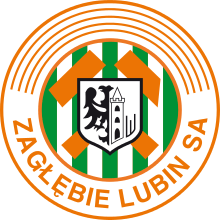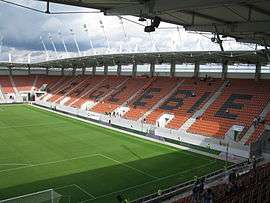Zagłębie Lubin
KGHM Zagłębie Lubin (Polish pronunciation: [zaˈɡwɛmbjɛ ˈlubin]) is a Polish professional football club based in Lubin, Poland. It was founded in 1945 as OMTUR Lubin.
 | ||||
| Full name | Zagłębie Lubin Spółka Akcyjna | |||
|---|---|---|---|---|
| Nickname(s) | Miedziowi (The Coppers) | |||
| Founded | 10 September 1945 (as OMTUR Lubin) | |||
| Ground | Stadion Zagłębia Lubin Lubin, Poland | |||
| Capacity | 16,100 | |||
| Chairman | Artur Jankowski | |||
| Manager | Martin Ševela | |||
| League | Ekstraklasa | |||
| 2018–19 | Ekstraklasa, 6th | |||
| Website | Club website | |||
|
| ||||
History
The history of Zagłębie Lubin dates back to August 1945, when former German town of Luben became Polish Lubin (see Recovered Territories). In a group of ethnic Poles, who were forced to abandon their homes in former Eastern Poland, was a number of football enthusiasts, including players and officials of Pogoń Lwów. Some of them were members of pre-1939, socialist Youth Organization of the Association of Workers’ Universities (Organizacja Mlodziezy Towarzystwa Uniwersytetow Robotniczych, OMTUR). In August 1945, they formed the OMTUR Lubin football team, which played its games at a former German field, located on Kosciuszko Street. The games of OMTUR Lubin were very popular, attracting crowds of people. Among the opponents, was the team of the local Red Army garrison, which faced the Poles in autumn 1945.
In March 1946, Sports Club Zawisza, based on OMTUR Lubin, was formed (the name comes after a medieval knight, Zawisza Czarny). Among its players were Emil Czyzewski of Pogoń Lwów, Tadeusz Rela of Tarnovia Tarnow, and Stanislaw Lesniewski, who had briefly played for Dynamo Kiev, and settled in the Recovered Territories. In April 1946, Autonomous District of Polish Football Association (PZPN) was formed in Wroclaw. Newly created teams from now Polish Lower Silesia were divided into four groups. Zawisza Lubin was in Group IV, winning promotion to the newly formed A Class. In 1947, Zawisza won the Cup of Lower Silesia, and in the same year, the team from Lubin faced the team of the Northern Group of Forces, headquartered in nearby Legnica. The game, which Poles won 1–0, was attended by Marshal Konstantin Rokossovsky.
In 1949, Zawisza Lubin changed name into Gwardia, and in 1951, to Spojnia. In 1953, the team returned to its original name, Zawisza.
In 1957, rich deposits of copper were discovered in the area of Lubin. With construction of the Lubin mine, the team gained a rich sponsor (see also KGHM Polska Miedz). In 1960, its name was changed into Gornik, and new departments were added: volleyball, basketball, boxing, handball, track and field, weight lifting and table tennis. Finally, in 1966, the Inter-Enterprise Sports Club (MKS) Zagłębie Lubin was established. The new organization was a powerful establishment, with 10 departments. Its football team won promotion to the third division, but Zagłębie’s officials demanded more. In 1974, Alojzy Sitko became its new manager. Zagłębie was a sensation in the 1975–76 Polish Cup, beating Ruch Chorzów, and then losing to Górnik Zabrze.
In 1975, Zagłębie won promotion to the second division, only to be relegated after one year. In 1978, it again was promoted, and relegated after one year. The team was a sensation in the 1978–79 Polish Cup, beating GKS Katowice, Legia Warszawa and Górnik Zabrze, and reaching the semi-final, where it lost 0–3 to Wisła Kraków.
In 1982, under manager Stanislaw Swierk, Zagłębie again won promotion to the second division. In 1985, it was finally promoted to the Ekstraklasa. With a new manager, Eugeniusz Rozanski, and a new stadium, Zagłębie was at that time one of the most powerful sports organization in Poland. On July 27, 1985, Zagłębie played its first Ekstraklasa home game, beating 1–0 GKS Katowice, after a goal by Eugeniusz Ptak. In the 1985–86 season, Zagłębie was 12th, in 1986–87, 8th, and in 1987–88, 11th. To avoid relegation, the team from Lubin had to participate in the play-offs, in which it lost to Górnik Wałbrzych (1–2, 2–2).
After one year in the second division, Zagłębie returned to the Ekstraklasa (June 1989). Managed by Stanislaw Swierk, it was Polish runner-up (June 1990), winning a spot in 1990–91 UEFA Cup. In the first round, Zagłębie faced Italian side Bologna, losing both games 0–1, 0–1.
In June 1991, managed by Marian Putyra, Zagłębie won Polish championship, earning a spot in the 1991–92 European Cup, where it faced Brøndby Copenhagen. The champion of Poland lost 0–3 in the first leg, and won 2–1 at home, to be eliminated. Among Zagłębie’s top players at that time were Romuald Kujawa and Adam Zejer, both top scorers of the Ekstraklasa in 1990 and 1991.
In 1995 Zagłębie was the 4th team in Poland, winning a spot in the 1995–96 UEFA Cup, to lose to the European powerhouse, AC Milan (with Roberto Baggio, Paolo Maldini, Alessandro Costacurta, Roberto Donadoni, Marcel Desailly, Zvonimir Boban, and manager Fabio Capello).
In June 2003, after 13 years, Zagłębie was relegated from the Ekstraklasa. Before that, Zagłębie played 20 games in the Intertoto Cup, with 7 victories, 5 ties and 8 losses. Furthermore, in 2001, it was the fifth team in Poland, also reaching semi-final of the Cup of Poland.
After one year Zagłębie returned to the Ekstraklasa (June 2004), and in spring 2005, it again reached the final of Polish Cup, losing 0–2 to Dyskobolia Grodzisk Wielkopolski. In 2005–06, under Franciszek Smuda, Zagłębie, with its top scorer Michal Chalbinski, finished third in the league, winning a spot in European cups. Furthermore, the team again reached the final of the Polish Cup, losing 2–3, 1–3 to Wisła Płock. In the UEFA Cup, Zagłębie was eliminated by Dinamo Minsk (1–1, 0–0).
Achievements
- Ekstraklasa:
- Winner: (2) 1990–91, 2006–07
- 2nd: (1) 1989–90
- 3rd: (2) 2005–06, 2015–16
- Second Division:
- Third Division
- Winner: (2) 1974–75, 1977–78
- Runners-up: (2) 1979–80, 1981–82
- Polish Cup:
- Finalist: (3) 2004–05, 2005–06, 2013–14
- Semi-Finalist: (2) 1978–79, 2000–01
- Polish SuperCup:
- Winner: (1) 2007
- Finalist: (1) 1991
- Polish League Cup:
- Finalist: (1) 2000–01
- Młoda Ekstraklasa:
- Champions: 2010, 2011
- Runners-up: 2012
- Polish U-19 Championship:
- Winners: (2) 2009, 2010
- Runner Up: (1) 1990
Zagłębie in Europe
| Season | Competition | Round | Club | Home | Away | Agg | |
|---|---|---|---|---|---|---|---|
| 1990–91 | UEFA Cup | 1R | Bologna | 0–1 | 0–1 | 0–2 | |
| 1991–92 | European Cup | 1R | Brøndby | 2–1 | 0–3 | 2–4 | |
| 1995–96 | UEFA Cup | Q | Shirak | 0–0 | 1–0 | 1–0 | |
| 1R | AC Milan | 0–4 | 1–4 | 1–8 | |||
| 1996 | UEFA Intertoto Cup | GR | SV Ried | 2–1 | 2nd | ||
| Silkeborg | 0–0 | ||||||
| Conwy United | 3–0 | ||||||
| Charleroi | 0–0 | ||||||
| 2000 | UEFA Intertoto Cup | 1R | Vilash Masalli | 4–0 | 3–1 | 7–1 | |
| 2R | Slaven Belupo | 1–1 | 0–0 | 1–1 (a) | |||
| 2001 | UEFA Intertoto Cup | 1R | Hibernians | 4–0 | 0–1 | 4–1 | |
| 2R | Lokeren | 2–2 | 1–2 | 3–4 | |||
| 2002 | UEFA Intertoto Cup | 1R | Dinaburg | 1–1 | 0–1 | 1–2 | |
| 2006–07 | UEFA Cup | 1Q | Dinamo Minsk | 1–1 | 0–0 | 1–1 (a) | |
| 2007–08 | UEFA Champions League | 2Q | Steaua București | 0–1 | 1–2 | 1–3 | |
| 2016–17 | UEFA Europa League | 1Q | Slavia Sofia | 3–0 | 0–1 | 3–1 | |
| 2Q | Partizan | 0–0 | 0–0 | 0–0 (4–3 p) | |||
| 3Q | SønderjyskE | 1–2 | 1–1 | 2–3 | |||
Current squad
- As of 13 April 2020[1]
Note: Flags indicate national team as defined under FIFA eligibility rules. Players may hold more than one non-FIFA nationality.
|
|
Notable former players
|
|
Out on loan
Note: Flags indicate national team as defined under FIFA eligibility rules. Players may hold more than one non-FIFA nationality.
|
Staff
- As of 18 September 2019[2]
- Martin Ševela – first coach
- Ivan Vrabec - assistant coach
- Paweł Karmelita - assistant coach
- Grzegorz Szamotulski - goalkeeper coach
- Marek Świder - fitness coach
- Dariusz Puchalski – chief physiotherapist
- Tomasz Pełech – physiotherapist
- Rafał Gąsecki – physiotherapist
- Karol Sitarski - coordinator
Managers
|
|
See also
References
zaglebie lubin (women soccer selection),(stadion Gorniczy),(dialog-arena),(Ulica Hutnicza),(head-coach)-(mr.Andrzej Turkowski),(ekstraliga kobiet),((2014/2015)-(Level:1)),(Poland),/(POL).
- "Pierwsza drużyna" (in Polish). KGHM Zagłębie Lubin. Retrieved 2 August 2015.
- Kadra
External links
| Wikimedia Commons has media related to Zagłębie Lubin. |
- Official website (in Polish)
- Unofficial website (in Polish)
- Zagłębie Lubin at 90minut.pl (in Polish)
